Scots take lead in campaign to cut stillbirths


In recent months, many health boards have started raising awareness of the importance of monitoring any changes in foetal movements to try to combat deaths in babies before they are born.
Now some are taking part in a major study, led by researchers in Edinburgh and funded by the Scottish Government, to offer training on foetal movements to health staff and pregnant women, which encourage them to seek immediate attention if they notice a decline in activity.
Advertisement
Hide AdAdvertisement
Hide AdThese women are then offered a set course of checks and monitoring of their babies. In some cases babies might be delivered early to help avoid stillbirth.
The rate of stillbirths in Scotland is at a record low, but still around one in 200 babies a year falls victim.
The Scottish Patient Safety Programme has announced a new focus on maternity issues, with a commitment to reduce stillbirths and neonatal deaths by 15 per cent by 2015.
Dr Catherine Calderwood, senior medical officer at the Scottish Government, said evidence suggested many women waited two days or more before seeking help after experiencing a drop in movements in their unborn child.
“Without wanting women to be alarmed, we want them to understand that it is important that they come and see somebody,” she said.
“Most of the time we can reassure them, but some of the time it will be important that they come because we definitely know that for some women it can be too late and we can’t do anything by the time they come to us.”
Calderwood said in the past women were told to count movements, but this was now considered old-fashioned and not very helpful.
“What we want women to try to understand is their own baby’s movements and reflect if those movements change or reduce,” she said. To get clear evidence of whether a greater focus on foetal movements can reduce stillbirths, the Scottish Government’s Chief Scientist Office is pumping £225,000 into the world’s first study on the issue, with further funding from baby charity Tommy’s, the Stillbirth and Neonatal Death charity (Sands) and Simba, which support parents who have suffered a stillbirth.
Advertisement
Hide AdAdvertisement
Hide AdThe four-year study, which will involve hospitals in Scotland as well as England, Wales and Ireland, is being led by Professor Jane Norman at Edinburgh University and will recruit 165,000 women. Calderwood said the study was necessary to prove the worth of monitoring foetal movements more closely and managing women in a standard way.
She said current practice varied between hospitals.
Dr Laura Price, from Sands, said: “We know that a change in the baby’s movements can be a late sign that he or she is in trouble, so it is vitally important that women and the health staff looking after them know what to watch out for and what to do if they have concerns.”
• A stillbirth is defined as a child born without signs of life after 24 weeks of pregnancy.
• In 2012 – the most recent statistics available – there were 274 stillbirths recorded in Scotland. This was out of a total of 58,301 births overall.
• This resulted in a rate of 4.7 stillbirths per 1,000 births – the lowest recorded in Scotland.
• Problems with the placenta were linked to 40 per cent of stillbirths in Scotland in 2012, with 16 per cent linked to haemorrhage and 11 per cent congenital anomalies.
• Advanced maternal age, obesity, deprivation, smoking, alcohol consumption, substance misuse and lack of maternal employment were all associated with an increased chance of both foetal and infant deaths.